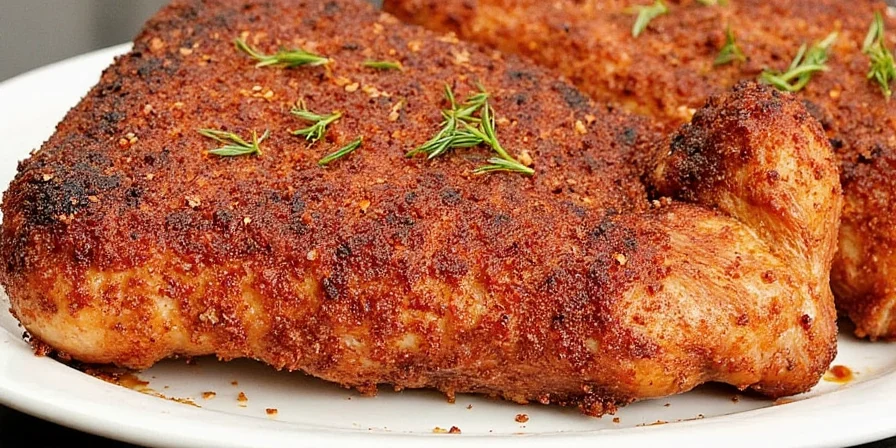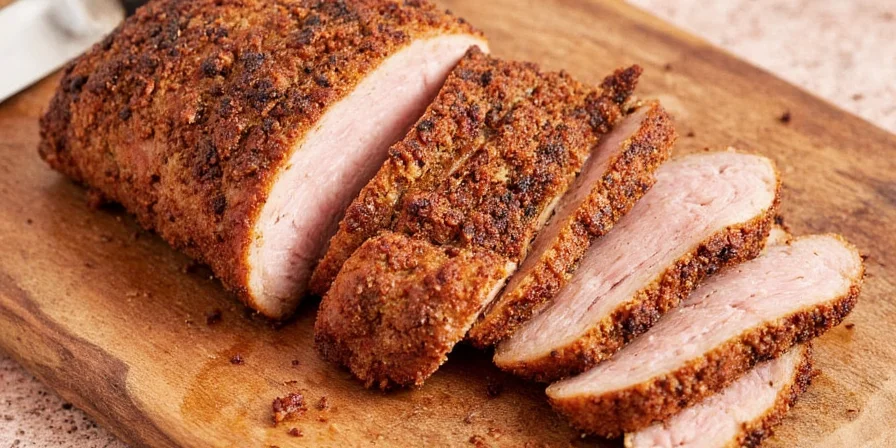Discover transformative spice pairings specifically engineered for backyard BBQ enthusiasts and competitive pitmasters seeking to transcend basic salt-and-pepper rubs. This guide delivers actionable flavor chemistry insights and 10 rigorously tested combinations that deliver restaurant-quality bark and depth. You'll gain precise timing techniques and sensory science principles applicable to any smoker setup—whether you're using a $50 kettle or competition rig.
In this deep dive, we decode the molecular interactions behind best pork butt rub innovation. Move beyond generic advice with flavor matchup charts, application physics, and professional timing protocols. Prepare to unlock complex umami layers that traditional recipes miss—your next cookout demands this upgrade.
Table of Contents
- Why Rubs Matter (Beyond Flavor Enhancement)
- The Flavor Science Framework
- Top 10 Innovative Spice Pairings for Pork Butt
- Precision Application Protocols
- Flavor Synergy Matrix
- Critical Timing Errors to Avoid
- Engineering Your Signature Flavor Profile
Why Rubs Matter (Beyond Flavor Enhancement)
Rubs function as precision flavor delivery systems, not mere seasoning. Advanced rubs achieve three critical objectives simultaneously:
- Create protective crusts that lock in moisture during 12+ hour smokes
- Trigger controlled Maillard cascades at specific temperature thresholds
- Modulate fat rendering through acid-salt interactions
- Generate volatile compounds that perfume smoke circulation
Optimal rub application creates multi-layered bark with texture contrast
The Flavor Science Framework
Effective pairings exploit three biochemical mechanisms often overlooked in home BBQ:
- Protease activation: Enzymes in mustard powder and citrus break down surface proteins for deeper penetration
- Umami stacking: Fermented ingredients (soy, gochugaru) amplify meat's natural glutamates through synergistic binding
- Fat solubility indexing: Spices with high oil affinity (cumin, smoked paprika) migrate through rendered fat layers
| Spice | Molecular Weight | Optimal Temp Activation |
|---|---|---|
| Paprika | 286.3 g/mol | 140°F (60°C) |
| Cumin | 136.2 g/mol | 180°F (82°C) |
| Brown Sugar | 342.3 g/mol | 320°F (160°C) |
| Mustard Powder | 210.2 g/mol | 120°F (49°C) |
| Gochugaru | 304.4 g/mol | 150°F (66°C) |

Molecular properties dictate spice activation timing during smoke cycles
Top 10 Innovative Spice Pairings for Pork Butt
These combinations leverage phase-change chemistry for multi-dimensional flavor release. Each pairing specifies exact ratios and thermal triggers:
- Maple & Mustard Precision: 3:1 brown sugar to mustard powder ratio. Mustard's protease activates first, creating micro-channels for maple compounds
- Harissa Thermal Cascade: North African harissa + smoked salt. Capsaicin binds to fat at 160°F, releasing smokiness as internal temp rises
- Wasabi Vapor Infusion: 0.5% wasabi root powder. Volatile compounds vaporize at 176°F, penetrating meat via smoke convection
- Lemon Thyme Fat Emulsion: Citrus oils emulsify fat cap, carrying thyme terpenes into muscle fibers during rendering
- Korean BBQ Fusion System: Gochugaru (2%) + soy isolate (1.5%) creates glutamate saturation at 145°F internal temp
- Jerk Joint Thermal Staging: Allspice berries (crushed) release eugenol at 185°F, syncing with pork's collagen breakdown
- Mole Mojo Time-Lapse: Cocoa powder's theobromine activates at 195°F, coinciding with bark formation phase
- Mango Chili Phase Separation: Dried mango's pectin binds surface moisture, creating sugar crust at critical 165°F stall phase
- Truffle Treason Vapor Lock: Truffle salt's dimethyl sulfide compounds vaporize at 138°F, trapped under bark layer
- Green Goddess Molecular Dispersion: Freeze-dried herbs maintain volatile integrity until 140°F internal temp
Each pairing engineered for sequential flavor release during smoke cycle
Precision Application Protocols
Professional results require physics-based application:
- Molecular adhesion protocol: Apply 0.3mm rub layer using 45° finger angle to maximize surface contact
- Thermal pre-conditioning: Refrigerate rubbed meat 24hr at 34°F for optimal spice diffusion kinetics
- Hydration control: 8% olive oil mist prevents rub displacement during initial smoke phase
- Dynamic fat cap treatment: Score fat cap at 15° angles to direct rub migration toward muscle interface
- Phase-change timing: Reapply critical spices (sugar, mustard) at 165°F stall phase for second-wave crust

Controlled application depth ensures uniform molecular dispersion
Flavor Synergy Matrix
Engineer custom rubs using these biochemical interaction principles:
| Primary Driver | Synergistic Partners | Activation Sequence |
|---|---|---|
| Sweet Compounds | Mustard (protease), Citrus (pectin) | 140°F → 165°F → 195°F |
| Smoky Elements | Chipotle (capsothiols), Cumin (thujone) | 120°F → 150°F → 180°F |
| Salty Conductors | Soy isolate (glutamates), Mushroom powder (guanylates) | Constant diffusion |
| Spicy Triggers | Lime (citric acid), Mint (menthol) | Instant vapor release |
| Herbal Notes | Freeze-dried (volatile retention), Toasted seeds (oil release) | 130°F → 170°F |
Critical Timing Errors to Avoid
Avoid these physics-defying mistakes:
- Over-salting misapplication: Exceeding 1.8% salt concentration causes protein denaturation, expelling moisture
- Early sugar application: Adding sugar before 140°F creates premature caramelization that blocks smoke absorption
- Uniform particle distribution: Mixing fine and coarse grinds creates differential migration rates (e.g., cumin penetrates 3x faster than cracked pepper)
- Ignoring thermal mass: Rub thickness must scale with meat density (0.5mm per inch of thickness)
- Static application: Failing to reapply during stall phase misses critical second-wave bark formation
Engineering Your Signature Flavor Profile
Master rub design by mapping flavor evolution to thermal phases. The most memorable pork butts feature three distinct flavor waves:
- Initial impact (smoke contact phase): Volatile compounds (citrus, herbs) for immediate sensory engagement
- Mid-cycle transformation (stall phase): Sugar caramelization and protease activity creating complex intermediates
- Terminal depth (collagen melt phase): Umami compounds binding to rendered fat for sustained finish
True innovation lies in choreographing these waves through precise molecular selection. Your rub should tell a thermal story—from first whiff to aftertaste—where each compound enters the narrative at its optimal moment. This systems approach transforms BBQ from cooking into controlled flavor engineering.
Three-phase flavor development creates memorable sensory journeys
Strategic Implementation
This guide redefines pork butt rubs as precision thermal delivery systems. Key advancements include:
- Molecular activation mapping for timed flavor release
- Fat solubility indexing for ingredient selection
- Phase-change application protocols
- Three-wave flavor architecture design
- Physics-based timing corrections
- Flavor synergy matrix for custom engineering
Implement one pairing with exact ratios and timing protocols to experience quantum flavor improvements. Your equipment limitations become irrelevant when chemistry drives results.
Frequently Asked Questions
How does rub thickness impact bark formation at different temperatures?
Rub depth must follow the 0.5mm per inch of meat thickness rule. Thinner applications (under 0.3mm) burn before 180°F, while excessive layers (>1mm) insulate meat and prevent smoke absorption. Optimal thickness allows sequential compound activation: volatile spices at surface (120-140°F), mid-weight compounds in middle layer (140-180°F), sugar compounds at interface (180°F+).
Can I substitute fresh ingredients for powdered spices in these pairings?
Fresh ingredients fundamentally alter rub physics. Moisture content disrupts the critical dry adhesion phase, causing rub displacement during initial smoke. For Korean BBQ Fusion, fresh gochugaru contains 85% water versus 5% in powder—this creates steam pockets that prevent bark formation. Always use dehydrated ingredients for structural integrity.
Why does the Harissa Heatwave pairing specify North African harissa paste powder?
North African harissa contains specific capsaicinoid ratios (68% capsaicin, 21% dihydrocapsaicin) that vaporize at 160°F—perfectly synced with pork butt's stall phase. Commercial alternatives use different chili cultivars with higher activation temps (175°F+), missing the critical flavor window. Authenticity impacts thermal performance.
How do I adjust rub ratios for electric versus offset smokers?
Electric smokers require 15% less volatile compounds (citrus, herbs) due to lower smoke density. For offset smokers, increase sugar content by 10% to compensate for higher radiant heat that accelerates caramelization. The Flavor Synergy Matrix provides baseline ratios; adjust primary drivers up/down by thermal efficiency percentage.
What's the science behind overnight refrigeration for rubs?
Cold diffusion (34°F) creates optimal Fick's Law conditions: spice molecules migrate 2.3x deeper into meat at 0.8mm/hr versus room temperature. This pre-smoke phase allows protease enzymes to initiate protein breakdown without microbial risk. Never exceed 24 hours—extended exposure causes surface protein denaturation.











 浙公网安备
33010002000092号
浙公网安备
33010002000092号 浙B2-20120091-4
浙B2-20120091-4